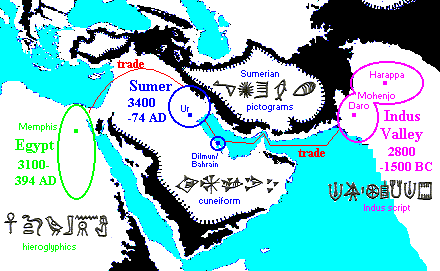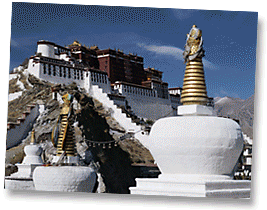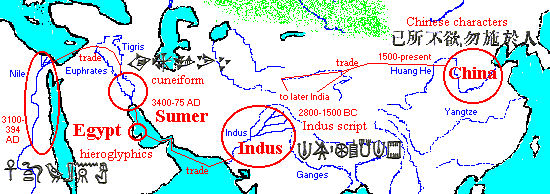| |
The basic meaning of civilization is the presence of cities, and the basic meaning of
history is the presence of written records. There can be civilization without writing (the
Incas), and perhaps writing without much in the way of cities (runes), but the creation of writing gives to the earliest historical civilizations a role that prior urban culture (as at Jericho) could not match. The four earliest centers of historical civilization stretch diagonally across south Asia into Africa. They are defined by their writing systems. The earliest is in Sumer (or
Sumeria), where we now have evidence of a long pre-history of writing. After early pictograms, the writing system that emerged,
cuneiform, is named after the wedge shapes that were made by reed pens on clay tablets. This was a cumbersome and messy medium for writing but possesses the virtue form our point of view that burned tablets can become as durable as bricks.

The Sumerians themselves did not last long, and are no longer distinguishable as a people after the end of the
III Dynasty of Ur, around 2000 BC. Their language has no known affinities, though the
Caucasus is still home to similarly isolated and unique language groups, three of them. A chain of ancient non-Indo-European and non-Semitic languages -- of Elam, the
Kassites, the Hurrians, and Urartu -- stretched from Sumer to the Caucasus, but too little is known of these languages, or of the early forms of the Caucasian ones, for certain connections to be drawn. Sumerian civilization, however, did not die, since most of its elements, and the cuneiform writing system itself, were adapted to writing a Semitic language,
Akkadian, whose daughters, Babylonian and
Assyrian, bore the literature of subsequent Mesopotamian civilization, even while lovingly preserving knowledge of Sumerian. The last cuneiform text is from 75 AD, and so this is taken as marking the end of Sumerian civilization, even if the end of the Sumerians themselves long antedates it.

Hard on the heels of Sumer came Egypt, with evidence of Sumerian influence, where a new writing system,
hieroglyphics, developed -- now with some evidence emerging of its antecedents in Egypt. Of the durable systems of writing, hieroglyphics alone retained its pictographic character, though the Egyptians developed
cursive and abbreviated forms for more practical purposes. The Egyptians also developed a more practical medium for writing, papyrus scrolls, though these have the drawback, from our point of view, of easily burning and decaying. An intact Egyptian papyrus is a prize, though these are more common in the dry climate of Egypt than similarly volatile media would be in the damp Ganges Valley of India. The Egyptians themselves, and their writing, were somewhat more durable than Sumer. The last hieroglyphic inscription was carved in 394 AD, and the last cursive (Demotic) papyrus is from 480 AD. That, even then, the Egyptian language survived, as Coptic, written in the Greek alphabet, is discussed
elsewhere.
The Indus Valley of India is where the next civilization emerges, again with evidence of Sumerian influence. The
Indus pictographic script is not well attested and remains
undeciphered. Nor, unlike hieroglyphics and cuneiform, are there any bilingual texts to aid in decipherment. The problem is that the Indus Valley civilization did not survive, flourishing only from around 2800 to 1500 (or even just from 2600 to 1900). The examples of Indus writing are brief and fragmentary. Just what happened is still mysterious. The advent of Indo-European
steppe peoples with horses and chariots undoubtedly had the kind of effect that is also evident in the Middle East, where small numbers of such people established regimes in Babylonia (the
Kassite Dynasty) and
Mitanni, and the technology made a foreign regime possible in
Egypt. The Indus cities, however, now seem already declining, vulnerable, and perhaps even abandoned, perhaps because of climatic and hydrological changes. There is little real evidence of violent conquest, though a similar absence is also noteworthy with respect to the Kassite regime in Babylon, the Mitanni, or the Hyksos in Egypt. In any case, India passed into a Dark Age and emerged contemporaneous with the beginning of Classical civilization in Greek, circa 800 BC.

While contact between Sumeria, Egypt, and the Indus occurred early, the fourth center of civilization, in China, remained relatively isolated and emerged considerably later, with the Shang Dynasty, about the time that India has passsing temporarily out of history. Of all the early systems of writing,
Chinese Characters, the direct descendants of Shang pictographs, are the only one still in use today. The Indian system, of course, ended with the Indus civilization. Cuneiform and hieroglyphics were replaced by alphabetic scripts that developed, perhaps under Egyptian influence, in Phoenicia and Canaan.
A striking geographical feature of the early civilizations is that they were all in river valleys, and not only that, but
desert river valleys. That circumstance might be overlooked in the Middle East, where the climate is uniformly dry, but is conspicuous in India and China, where the rivers in deserts (the Indus), or at least relatively dry areas (the Huang He), are matched by rivers that are in areas of heavy rainfall (the Ganges & Yangtze). In China, an old saying has it that in the north (Huang He valley) you go by horse, and in the south (Yangtze valley) you go by boat. That life and agriculture likely was
easier in rainy areas may have been just the problem. The irrigation systems that were necessary for reliable agriculture in the desert climates imply a level of organization and technological development, let alone records, which are just what we find in the earliest days of Sumer, Egypt, and the Indus valley. In these terms, it should not be surprising that civilization in India began on the Indus rather than the Ganges, and in China on the Huang He rather than the Yangtze. This even made a difference in the Chinese diet, since rice, which we think of as the Chinese staple, would only grow in the wet south. In the north, it was wheat that was grown, and the staple diet was based on something else which is still conspicuous in Chinese
cooking, noodles.

Another curious, but unexplained, feature of these civilizations is that the delay in the develoment of China, and the hiatus in the development of India, end up producing a
philosophical culture simultaneously with the development of Greek philosophy, while the independent Egyptian and Mesopotamian civilizations were far gone in decline. The multiple points of similarity between the thought of the Greece, India, and China, evident in the simplest terms in their respective treatment of the physical
elements, cannot be accounted for by mutual influence, which does not seem to have existed at the earliest period. The undoubted transfer of ideas between Greece and India in the
Hellenistic Period, and the export of Buddhism from India to China beginning in the
Han Dynasty, provides us points of comparison with what, the uninfluenced traditions, came before. The time when
Parmenides,
Confucius, and the
Buddha all lived, the end of the 5th century BC, has been called the "axial age"; but it remains mysterious that such simultaneous and sometimes parallel development should have occurred.
The age was also one of religious innovation. In India, where religion and philosophy remain closely related, Buddhism, Jainism, and Upanishadic Hinduism straddle the distinction. In China, schools that are pretty purely philosophical, Confucianism and
Taosim, eventually attract religious elements and grow, with Buddhism, into the three religious "Ways" of Chinese civilization. Greek religion, of course, was doomed to extinction, replaced by Prophetic Judaism and its daughter religions, Christianity and Islâm. Meanwhile, of course, the Jewish tradition had been profoundly influenced by Greek philosophy, so that when Christianity was adopted by Rome, it could be said to repesent a synthesis of "Athens and Jerusalem." The place in this of the religious revolution in Irân, Zoroastrianism, is more obscure. The moral rigor of Zoroaster, in separating all evil from God, may actually be the source of similar reforms in both Judaism and in Greek philosophy, but there is little in the way of direct evidence of this.
|
|






